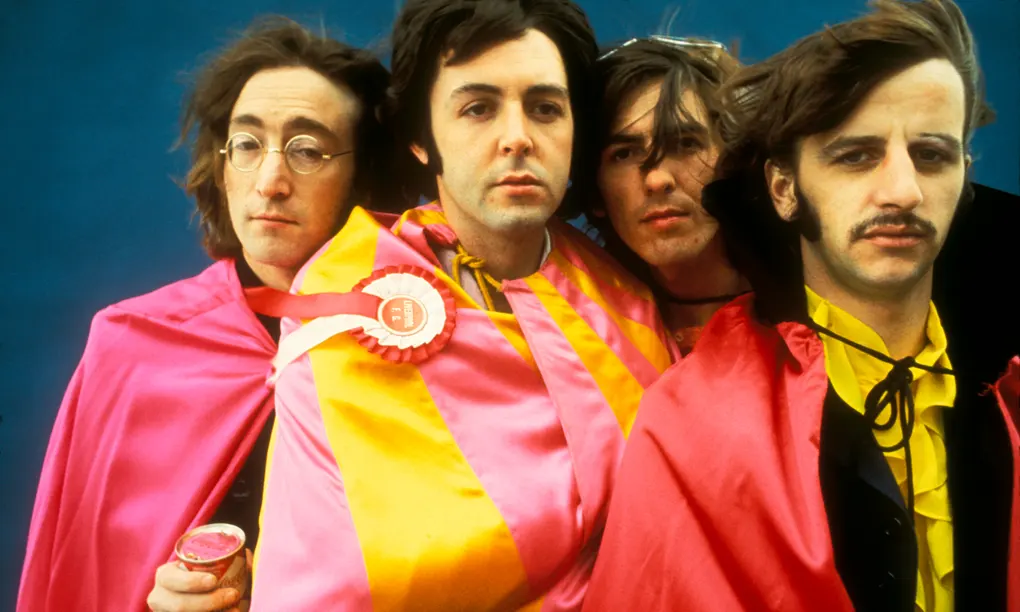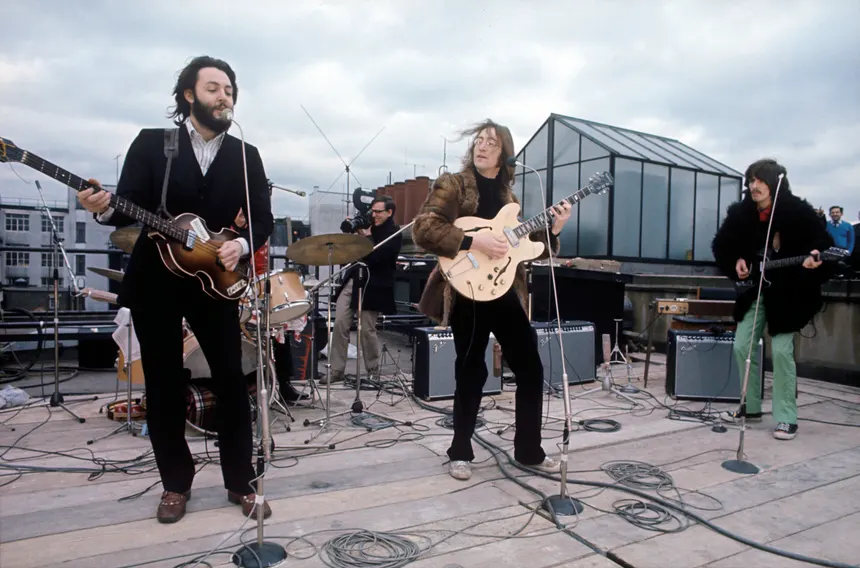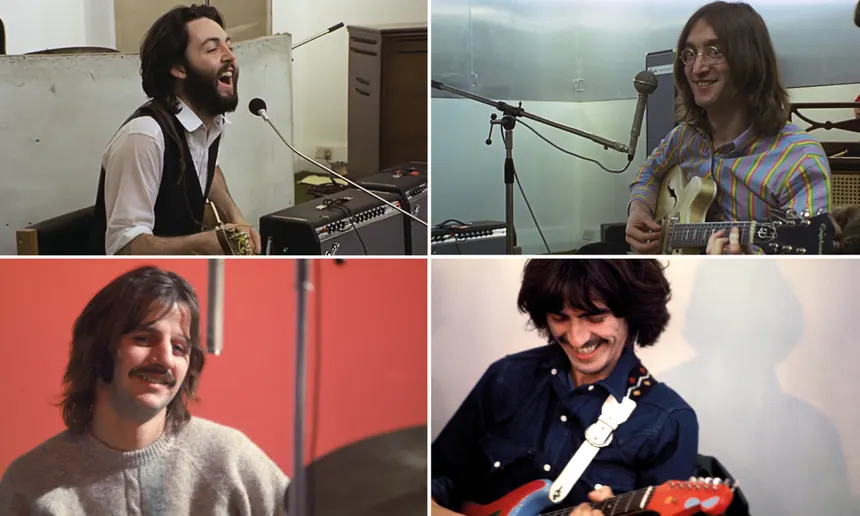‘I Just Can’t Believe It Exists’: Peter Jackson Takes Us into the Beatles Vault Locked Up for 52 Years
MUSIC, 22 Nov 2021
Andy Welch | The Guardian - TRANSCEND Media Service
20 Nov 2021 – Ahead of his epic series Get Back, the director reveals the secrets of 60 hours of intimate, unseen footage of the Fab Four – and why it turns everything we know about their final days upside down.

‘The whole thing boggles my mind’ … Jackson on The Beatles: Get Back.
Photograph: Don McCullin/Press Images/Eyevine
When the world closed down in March 2020, most of us had to make do with pretending to enjoy video calls with friends or baking bread. Peter Jackson, meanwhile, was busy sifting through a mountain of unseen footage – 60 hours in total – of the Beatles, shot by the director Michael Lindsay-Hogg in 1969.
His four-year project is now finished – “we finally completed it on Friday,” says a relieved-looking Jackson from his home in New Zealand – and the resulting series, The Beatles: Get Back, will be released on Disney+ from 25 November. Originally envisaged as a feature film, Covid uncertainty saw plans revised. It is now three two-hour episodes, using the mass of outtakes from Lindsay-Hogg’s work on what would become Let It Be, the band’s fourth feature film.
It is striking just how much joy is contained within the vivid and eerily detailed footage. Contrary to almost all accounts over the past 52 years, John, Paul, George and Ringo are seemingly happy to be in the studio: laughing, joking, singing in the style of ventriloquists, talking about last night’s TV (Peter Cook and Zsa Zsa Gabor having a spat) and, of course, writing music. Taken at face value, it’s a unique insight into a band at work, restored to a modern, HD sheen. But, more than that, it’s a study of four of the most idolised and scrutinised individuals in the world in their prime. This is not just a music documentary, it’s a history book come to life.
“I just can’t believe it exists,” says Jackson, in the manner of a man still yet to come to terms with what he was allowed to do. “But then I can’t believe any of it – that the Beatles let Michael shoot all that footage, that it sat in a vault all this time …
“What other band in the 60s or 70s allowed themselves to be shot in such an intimate way? There isn’t another. And then I got to edit it. The whole thing boggles my mind.”
Jackson’s involvement goes back to 2017, when he was contacted by Apple Corps – the company set up by the Beatles in 1968, and which handles all of the band’s affairs – not for help with a film or TV series, but due to his interest in virtual and augmented reality technology. Perhaps inspired by the successes of the David Bowie and Rolling Stones exhibitions, the company was hatching plans for a similar Beatles museum show. Those plans, Jackson believes, have since been abandoned, but the interaction with Apple Corps led him to enquire about using the mythic Let It Be footage, unseen for half a century.
Eventually, Jackson received permission, although he had one condition: he didn’t want to make a miserable film so wanted to see all the footage first. Indeed, previous attempts at using it had ended in failure. Acknowledging its existence in the 00s, Apple Corps mooted plans to have the film restored and rereleased, but quickly shelved them.
That is perhaps unsurprising, given the context of the album and the original film. Let It Be was, as the perceived wisdom goes, a miserable experience. John Lennon referred to the sessions as “six weeks of hell”, while George Harrison has called the whole period “the Beatles’ winter of discontent”. Even the usually glass-half-full McCartney has said that in attempting to offer a fly-on-the-wall view of a Beatles album being made, what they had really done was show the world what the breakup of a band looks like.
Lindsay-Hogg’s film was finally released in May 1970, and was panned by critics and unloved by fans. With this in mind, the question of why anyone would want to sit through this footage now is a valid one. But Jackson was stunned by what he saw that first week, watching it from morning till night at Apple Corps’ London office and being brought a daily Big Mac. “I was amazed,” he says. “I was waiting for it to get really bad but it didn’t. It actually gets happier and happier as it goes.”
Knowing what he now knows, it’s a mystery to Jackson why each Beatle, along with their producer George Martin, always viewed the Let It Be sessions with such hatred – but he has a theory. “I’m convinced they were all remembering May 1970 and their reaction to the movie upon release, rather than how they felt filming it,” he says. Indeed, there are conflicting accounts – Glyn Johns, who worked as a recording engineer on the Let It Be sessions, remembers it being a funny, happy time in his autobiography, Sound Man, while Lindsay-Hogg has said similar. “But maybe they can say that,” says Jackson. “They weren’t in a band that was breaking up.”
After finishing They Shall Not Grow Old, his acclaimed first world war documentary released in 2018, Jackson got to work on Get Back. First, there was a forensic exploration of the period. He met McCartney, Starr, Sean Lennon and Harrison’s son, Dhani. He has been in regular contact with Lindsay-Hogg, went to the Savile Row rooftop where the Beatles performed their last ever gig, and even met the police officers who went up on to the roof to tell the most famous musicians in the world to stop playing.
Then came the restoration work, a frame-by-frame process to sharpen the footage for modern TVs, which took 14 people almost four years. Editing – Jackson’s favourite part of film-making – was difficult, he says, simply because of the wealth of material. At one point, he says he was happy with an 18-hour Get Back cut, but managed to whittle it down to a third of that.
The resultant six hours contain more than enough revelations, and no little sadness. That is not necessarily because of the breakup round the corner, but because it depicts four men, still in their 20s, who – having changed the world – just want to go back to being four lads from Liverpool. Tellingly, even at this point, they’re extremely nostalgic, regularly discussing their time in Hamburg in the early 60s, or playing at the Cavern in Liverpool. They reference a running joke from A Hard Day’s Night and cover early rock’n’roll classics such as Blue Suede Shoes and Shake, Rattle and Roll – anything to help them get back to where they once belonged.
Perhaps none felt more frustrated than Harrison, who briefly left the band early on in the sessions only to return on the proviso that plans for a concert in Libya were scrapped. In Lindsay-Hogg’s original, the Beatles insisted that footage of Harrison’s departure stay off-limits. In Get Back, we see the whole incident. “Anyone thinking this is going to be a whitewash, think again,” says Jackson. “I didn’t want to hold back or sanitise anything, but there was a very positive reaction from everyone, even if some of them said parts of it were stressful to watch.”
There are indeed tough moments. One tense episode is the barbed exchange between McCartney and Harrison, which was given huge prominence in Lindsay-Hogg’s film (“Whatever it is that would please you, I’ll do it,” says a weary Harrison). It features in Get Back, too, although Jackson believes editing made it more frosty in the original than it actually was. “The whole conversation was about 90 minutes, and we have eight or nine minutes of it, with that exchange in the middle,” he says. “It’s nowhere near as bad.”
While Jackson was uninterested in helping the Beatles settle scores, he was pleased to put to bed the story that Harrison left the group due to a physical fight with Lennon. Thankfully, there’s filmed evidence of the pair reading the fanciful newspaper story responsible for sparking the myth and threatening to sue the journalist.
Another moment that gave him particular delight involves McCartney discussing Lennon and the presence of his soon-to-be wife Yoko Ono in the studio (at one point we watch Lennon and Ono celebrate, mid-song, as they get the news that Ono’s divorce has been finalised). McCartney, as if gazing into a crystal ball, says: “It’s going to be such an incredible sort of comical thing, like, in 50 years’ time, you know: ‘They broke up because Yoko sat on an amp.’”
“I was stunned when I first heard that,” says Jackson. “Of course, they didn’t break up because of Yoko, but Paul can do an interview today and say it wasn’t and people will take it with a grain of salt. You can’t do better than [having] a contemporary source.”
Get Back will likely be the end of Jackson’s time working with the Beatles – mainly because there isn’t another vault full of material. But he says the hours spent on the film have only increased his respect for John, Paul, George and Ringo.
“Now, they are our grandparents or great-grandparents,” he says. “But here, John and Ringo are 28, Paul is 26 and George is 25, and you never once feel this footage is 52 years old. I’ve always thought their music transcends generations, but this will make them seem young again.”
________________________________________________
Andy Welch is an assistant production editor at the Guardian.
Go to Original – theguardian.com
Tags: Art, History, Music, The Beatles
DISCLAIMER: The statements, views and opinions expressed in pieces republished here are solely those of the authors and do not necessarily represent those of TMS. In accordance with title 17 U.S.C. section 107, this material is distributed without profit to those who have expressed a prior interest in receiving the included information for research and educational purposes. TMS has no affiliation whatsoever with the originator of this article nor is TMS endorsed or sponsored by the originator. “GO TO ORIGINAL” links are provided as a convenience to our readers and allow for verification of authenticity. However, as originating pages are often updated by their originating host sites, the versions posted may not match the versions our readers view when clicking the “GO TO ORIGINAL” links. This site contains copyrighted material the use of which has not always been specifically authorized by the copyright owner. We are making such material available in our efforts to advance understanding of environmental, political, human rights, economic, democracy, scientific, and social justice issues, etc. We believe this constitutes a ‘fair use’ of any such copyrighted material as provided for in section 107 of the US Copyright Law. In accordance with Title 17 U.S.C. Section 107, the material on this site is distributed without profit to those who have expressed a prior interest in receiving the included information for research and educational purposes. For more information go to: http://www.law.cornell.edu/uscode/17/107.shtml. If you wish to use copyrighted material from this site for purposes of your own that go beyond ‘fair use’, you must obtain permission from the copyright owner.

